The True Story of Oak Island and Arcadia. By Cort Lindahl
PART 1
What if the story of Oak Island is essentially a fictional story that had been told long before anyone supposed the presence of treasure there? Is it possible that this story had been applied to the island for reasons other than inspiring the reader to look for treasure? The truth may reveal that the entire saga was meant to inform one of the true nature of the name Acadia (Arcadia) while also displaying the contentious history of what would eventually come to be known as Nova Scotia. As the story unfolds, it is clear that the French and English factions of Nova Scotia and the other maritime provinces had a distinct value of the Arcadian concept from the same Greek mythology.
A value of Arcadia also involves a value of navigation with regard to the Pole Star, also known as Stella Maris. The name Arcadia derives from the Greek mythological character Arcas. Ultimately, Arcas and his mother are cast into the sky with Arcas as Ursa Minor and Ursa Major. The Pole Star is located at the tip of the tail of Ursa Minor, making this an essential constellation to both Pilgrims and Pilots. This somewhat hidden navigational theme is valued throughout the entire tale of “Arcadia” and the real people surrounding the Oak Island mystery. The theme of Arcadia is also one of a pastoral utopia where life is good and simple.
It is clear that both the French and English factions of Acadia valued this mythology and its pastoral themes. Though the Academy of Arcadia of the Vatican was formed in the mid-seventeenth century, these themes are especially evident in the application of the name Larcadia to this region by Italian cartographer Bolongnini Zaltieri in 1566. Bolongnini had likely used this name in response to explorer Verrazano’s naming of what would become Delaware “Archadia” during his 1525 voyage. Initially, these regions were claimed by France, yet soon disputed by England. When the French first settled the area of Port Royal, Nova Scotia, in 1605, they became known as “Acadians.” The use of this name comes from an era of history during which the image of Greek Arcadia as a pastoral utopia was appreciated and began to manifest itself in visual and literary arts.
With this in mind, it is no surprise that Verrazano and Bolongnini chose to use this name for previously unnamed regions during their voyages. Given this, it is easy to see why later artists and writers value and revere this concept via their literary guild of Arcadia. Using literary guilds may reveal much about the Mystery of Oak Island and many other questions that have been placed in the public’s minds. One literary figure in particular may hide the secret of the Oak Island Treasure! The Academy of Arcadia of the Vatican was established in the mid-seventeenth century. It likely included among its members Nicolas Poussin, famous for his renderings of “The Shepherds of Arcadia,” known in the mysteries of Shugborough Hall and Rennes le Chateau. As it may be discerned, another somewhat earlier literary guild seemed to value the Arcadian theme in England.
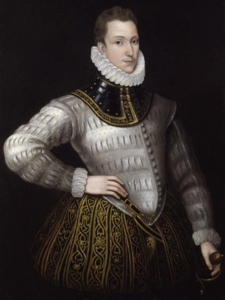
Sir Philip Sidney
Sir Philip Sidney was a writer and courtier during the Elizabethan era. He and his sister Mary, Sidney Herbert Cou,ntess of Pembroke, were favorites at court. Philip and Mary were talented writers of Mary’s Writer’s Guild, known as the Wilton’s Writers Circle. Many speculate about this guild’s involvement in producing Shakespeare’s works and participation with Sir Francis Bacon and Edward de Vere, the 17th Earl of Oxford. Mary Sidney, Countess of Pembroke, also once penned a book about Enochian Geomancy or the reading and interpretation of lines on the earth.
In about 1570, Philip dedicated an extensive work to his sister, titled “Arcadia.” This time refers to the idyllic land of Greek Arcadia and, as we will see, provided a few moments of crucial history to the world of mystery and intrigue. Some of the story’s details include the book opening with a maritime battle that provides for pirates and the destruction of the two protagonists’ ships, leaving them stranded in Arcadia.
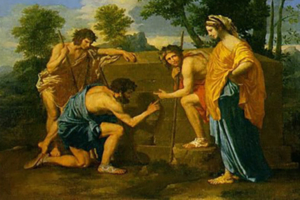
Shepherds of Arcadia by Nicolas Poussin. The tomb bears an inscription, “Et in Arcadia ego.”
Mary Sidney Herbert, Countess of Pembroke’s sons, married the daughters of the 17th Earl of Oxford, Edward de Vere. The Herbertsons were great patrons of the arts. They funded the publication of the famous First Folio of Shakespeare, as evidenced by the book’s dedication to them by renowned author Ben Jonson. The First Folio is an exciting publication of Shakespeare and is thought by many to contain codes and ciphers. The First Folio and all of Shakespeare’s works postdate the authorship of “Arcadia” by Philip Sydney but did occur in the era during which William Alexander edited the work. If these code crackers are correct, these ciphers were placed in the First Folio in response to what Philip Sydney had written in “Arcadia,” which was first written when Bacon was about twelve years old. Again, this may indicate that the suggestion of treasure at Oak Island had come from and had been a copy of the story included in Sidney’s work. The First Folio was published in 1621. Sidney wrote “Arcadia” in the 1570s and finished by 1580. His siHisy Sidney Herbert, Countess of Pembroke, and later William Alexander, 1st Earl of Stirling, amended and edited the work. It is clear that Sir Francis Bacon had nothing to do with the production of “Arcadia,” nor did the ciphers in the first folio refer to his work. They refer to something Philip Sidney had written or done. Not Sir Francis Bacon.
King Charles I’s last words were from a portion of Sidney’s “Arcadia,” known as “Pamela’s Prayer.” This, in turn, leads us to the imagery of “Et in Arcadia Ego” on the Shepherd’s Monument of Shugborough Hall and will unravel the mystery of Oak Island as well as point to solutions to other mysteries such as the Bruton Parish Church Vault of Jamestown and Williamsburg and the Beale Treasure of Virginia. Throughout all these mysteries, the Arcadian theme or use of the Pole Star to navigate from clue to clue to find treasure is central. This includes Oak Island, Rennes le Chateau, and Shugborough mysteries. This information proves that the Shepherds Monument was intended as a memento mori for the beheaded Charles I. In addition, as this tale unravels, we will see direct connections to a series of famous mysteries. Amazingly, artwork and architecture present at Admiral Anson’s other estate, Moor Park, unravels the entire mystery. Philip Sidney also owned Moor Park, only a few miles from Sir Francis Bacon’s Gorhambury Estate.
What will be revealed will also connect the octagonal Kings Knot of Stirling Castle, initially built by Charles I, to the Tower of the Winds of Shugborough Hall and the strange star in the landscape of Rennes le Chateau as defined by brilliant author Henry Lincoln. The octagonal Kings Knot “points to” both the Tower of the Winds of Shugborough and the star in the landscape of Rennes le Chateau as defined by Henry Lincoln. The star at Rennes, in turn, “points back,” thus defining a single arc on the globe that includes the Shugborough Tower of the Winds between the two. It will soon become apparent why and how all these places and themes are related, including Oak Island. The Arcadian mysteries are all linked via a geographic scheme indicated by monuments at each location.
What if, in addition to all these revelations, Philip Sidney’s “Arcadia” also revealed the original story of how the Money Pit on Oak Island was found? In fact, “Arcadia” contains the exact story that reflects the origins of the modern Oak Island myth as it is read today. What if there was a direct connection between Charles I and the Arcadian theme that would rationalize why all the monuments and associated mysteries at Stirling, Shugborough, and Rennes le Chateau even exist in the first place? What if the entire scheme also included Oak Island, Nova Scotia?!
The original folklore of Oak Island tells of how three young men sighted strange lights on the Island and went to investigate. Upon a search of the Island, a strange depression was found with a ship’s tackle hanging from the branch of an Oak Tree above. The young men excavate the pit, hoping local tales of pirates’ hoards could be true. First, the surface of the depression was covered with flagstones. They excavated strange platforms of oaken logs until finally, at about ninety feet, a strange stone was encountered that included an enigmatic inscription that some interpret as saying treasure is located in a vault below. The story is similar to the young men living and owning property on the island. It may be that the men who found the treasure had once been part of Montagu’s “Carolina Corps” during the Revolutionary War, with some initially being from Virginia and North Carolina.
Below is an excerpt from Philip Sidney’s “Arcadia,” published in 1580. We see almost the exact story being told. “Arcadia” had been published over two hundred years before the first revelation of any hint of treasure at Oak Island as exposed in the original tale. Here now read the truth of the Oak Island Money Pit:
“Master,” answered Dorus, ” you have so satisfied me with promising me the utmost of my desired’ bliss that if my duty bound me not, I were in it sufficiently rewarded. To you, therefore, shall my good hap be converted, and the fruit of my labor dedicated. In addition to that, he told him how under an ancient oak (the place he made him easily understand by sufficient marks he gave to him) he had found digging but a little depth, scattering lying a great number of rich medals, and that, piercing farther into the ground he had met with a great stone, which, by the hollow sound it yielded, seemed to be the cover of some greater vault, and upon it a box of cypress, with the name of the valiant Aristomenes, graven upon it : and that within the box he found certain verses which signified that some depth again under that all his treasures lay hidden, what time for the discord fell out in Arcadia, he lived banished. Therewith he gave Dametas certain medals of gold he had long kept about him, and asked him, because it was a thing much to be kept secret, and a matter one man in twenty hours might easily perform, whether he would have him go and seek the bottom of it, which he refrained to do till he knew his mind promising he would faithfully bring him what he found, or else that he himself would do it, and be the first beholder of that comfortable spectacle ; no man need doubt which part Dametas would choose, whose fancy had already devoured all this great riches, and even now began to grudge at a partner, before he saw his own share. Therefore taking a strong jade, laden with spades and mattocks, which he meant to bring back otherwise laden he went in all speed thitherward, taking leave of nobody, only desiring Dorus he would look well to the princess Pamela, promising him mountains of his own labour, which nevertheless he little meant to perform, like a fool, not considering, that no man is to be moved with part, that neglects the whole.
Thus away went Dametas having already made an image in his fancy, what palaces he would build, how sumptuously he would fare, and among all other things imagined what money to employ in making coffers to keep his money ; his ten miles seemed twice so many leagues, and yet contrary to the nature of it, though it seemed long, it was not wearisome. Many times he cursed his horse’s want of consideration, that in so important a matter would make no greater speed : many times he wished himself the back of an ass to help to carry away the new sought riches (an unfortunate wisher, for if he had as well wished the head, it had been granted him). At length being come to the tree, which he hoped should bear so golden acorns, down went all his instruments, and forthwith to the renting up of the hurtless earth, where by and by he was caught with the lime of a few promised medals, which was so perfect a pawn unto him of his farther expectation that he deemed a great number of hours well employed in groping farther into it, which with logs and great stones was made as cumbersome as might be, till at length, with sweaty brow, he came to the great stone. A stone, God knows, full unlike to the cover of a monument, but yet there was the cypress box with Aristomenes graven upon it, and these verses written in it,
A banish’d man, long barr’d from his desire
By inward lets, of them his state possessed,
Hid here his hopes, by which he might aspire.
To have his harms with wisdom’s help redressed.
Seek then and see what man esteemeth best,
All is but this, this is our labour’s hire :
Of this we live, in this we find our rest ;
Who holds this fast no greater wealth require,
Look farther then, so shalt thou find at least,
A bait most fit for hungry minded guest.
He opened the box, and to his great comfort read them, and with fresh courage went about to lift up that stone. But in the meantime, e’er Dametas was half-a-mile gone to the treasure-ward, Dorus came to Miso……
Later in the story:
THE almighty wisdom evermore delighting to show the world that by unlikeliest means greatest matters may come to conclusion ; that human reason may be the more humbled, and more willingly give place to divine providence; as at the first it brought in Dametas to play a part in this royal pageant, so having continued him still an actor, now that all things were grown ripe for an end, made his folly the instrument of revealing that which far greater cunning had sought to conceal. For so it fell out that Dametas having spent the whole day in breaking up the cumbersome work of the pastor Dorus, and feeling in all his labour no pain so much as that his hungry hopes received any stay, having with the price of much sweat and weariness gotten up the huge stone, which he thought should have such a golden lining, the good man in the great bed that stone had made, found nothing but these two verses written upon a broad piece of vellum.
Who hath his hire, hath well his labour plac’d ;
Earth thou didst seek, and store of Earth thou hast.“
The above narrative from “Arcadia” seems to be the source of the tale still told today in relation to Oak Island. Of course, the alternate name of Nova Scotia is Acadia, which is also French or short for Arcadia. The fictional work does reveal the solution to a missing “treasure” that has not yet happened at Oak Island. This literary work takes place in the original Arcadia of Greece and does not, at first glance, have anything to do with Nova Scotia. Or does it? Given all the similarities in this story to the original tale of Oak Island, there is no way this story in Nova Scotia could not derive from Philip Sidney’s “Arcadia.” If this fictional tale is the source of the Money Pit story, then this does not bode well if the real Money Pit serves the same purpose as the one in the story. “Arcadia” is indeed a story about Acadia.
This story describes a hidden or lost treasure stash that someone had dug for and found some of the loot. He then sends another person to search for what remains at the same site. This would leave a depression in the ground, as described in the original story. The inclusion of Aristomenes’ box also fits the Money Pit story, as does the inclusion of a graven stone reminiscent of the “ninety foot” stone said to have been found at the Money Pit. The papers in the box indicate a treasure hidden below, possibly in a vault where the box and stone were found. The description of “logs and stones” being removed also resembles the layers of oaken logs said to have been encountered in the Money Pit story. Some suggest the story of Sir Francis Bacon’s papers being present at both Jamestown/Williamsburg and Oak Island. Something similar is also told in this excerpt of “Arcadia.” The plot of “Arcadia” reveals that the treasure story is simply an elaborate ruse to confound Dametas while Dorus escapes with the object of his desire. Other aspects of “Arcadia” mention pirates and looted treasures but not in relation to the treasure story discussed here.
Sir William Alexander, 1st Earl of Stirling, admired Philip Sidney’s work. He was a favorite at the court of James I. William had even been educated with the future king Charles I in Scotland as a young man. His association with Charles may indeed link us back to Shugborugh Hall and the notion that the Shepherds Monument is a memento more for Charles. The Shepherds Monument may display a strange small casket or reliquary representing the Oak Island treasure. Eventually, Sir William would be given Nova Scotia in one of the early English possessions of the Maritime region. He intended to establish a Scottish Colony and is credited with naming the area Nova Scotia. Sir Alexander originates the Baronetcies of Nova Scotia and the Nova Scotia flag. This region’s history has passed back and forth from English to French hands several times in a contentious manner that was not solved until after General George Lawrence’s invasion in the early eighteenth century. Strangely, William Alexander, 1st Earl of Stirling, also has a direct and unmistakable link to the Arcadian concept that French influences had already applied to the region.
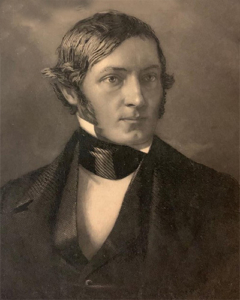
Poet William Alexander, 1st Earl of Stirling
William Alexander wrote an addendum to Philip Sidney’s “Arcadia” in 1621 that does not include this strange tale resembling the later Legend of the Money Pit at Oak Island. The first governor of Acadia had written part of “Arcadia.” This means Philip Sidney is the source of the story that would later seemingly be copied at Oak Island in Arcadia. Still, Alexander’s addendum was about one hundred and seventy-four years before the revelation of the story we all know and love at Oak Island. This fantastic fact, coupled with the presence of the Oak Island story so long before its use later, near the turn of the nineteenth century, has been examined differently. This information may also reveal that the entire later manifestation of the Legend of the Money Pit was contrived and that no treasure is located at Oak Island. The first Baron or Governor of Arcadia wrote part of “Arcadia!”
Of course, this story may also be interpreted as the template for depositing valuable items as described in both the Legend of the Money Pit and Sidney’s “Arcadia.” The fact that this fictional tale was composed long before the Money Pit was discovered may indicate the falsehood of the entire later history that has them simply copying a tale germane to the history and identity of Acadia or Nova Scotia. An alternate scenario this story suggests would mean that the treasure had already been found if true. The fact that the Money Pit story had been crafted from “Arcadia” may also indicate the folly of the original story. Or had men later replicated the entire story at Oak Island to hide a real treasure? Though that would have been difficult, it does not make sense unless someone intentionally conjures images from Sidney’s “Arcadia.” Though this tale in Arcadia does not mention the Oak in question being located on an Island, could he have known of a treasure there as early as 1570?
One crucial factor that may point to the existence of real treasure at Oak Island is Philip Sidney’s close friendship with Sir Francis Drake. Drake is included in a long list of people who potentially created the Money Pit, and the chronology of his voyages indicates that Sidney could have included his “Arcadian” treasure tale in response to something Drake had told him. Still, even if Drake was involved, there is no record of him coming to Nova Scotia. However, his position in the English naval hierarchy would have exposed him to much information from other sailors and sea captains.
In the end, the repetition of the theme and identical elements of the story point to the fact that the later Money Pit mystery was crafted to intentionally match the story from Sidney and Alexander’s “Arcadia.” That is almost without question at this point. There may be many accurate and verifiable reasons that this is true within the scope of intelligence services and the use of literature and art as weaponized constructs. Again, the entire cast of characters on both the French and English sides of the story have direct relations to the intelligence networks of the monarchies of France and England. The defacto intelligence network of the Society of Jesus, also known as the Jesuits, is thrown into the mix.
Many elements of the progression and editing of “Arcadia” later resemble the way the famous work “Amadis de Gaula” progressed, with one addendum being the earliest source of the name “California.” Works such as these may have contained hidden metaphors or codes that would only be appreciated by an initiate or one intimately associated with the history surrounding them. Evidence of this comes from a communication from Fulke Greville to Sir Francis Walsingham. Sir Francis was also Philip Sidney’s father-in-law. Walsingham was considered one of the “spymasters” of Queen Elizabeth and held close relations with many people in this tale. Greville’s concern seems to stem from the fact that portions of Sidney’s “Arcadia” are too revealing to be published:
“Sir, this day one Ponsonby, a bookbinder in Paul’s Churchyard, came to me and told me that there was one in hand to print, Sir Philip Sidney’s old Arcadia asking me if it were done with your honor’s con[sent] or any other of his friends/I told him to my knowledge no, then he advised me to give warning of it, either to the Archbishop or Doctor Cosen, who has as he says a copy of it to peruse to that end/Sir I am loath to renew his memory unto you, but yet in this, I must presume, for I have sent my Lady your daughter at her request, a correction of that old one done 4 or 5 years since which he left in trust with me of which there is no more copies, and fitter to be printed than that first which is so common, notwithstanding even that to be amended by a direction set down under his hand how and why, so as in many respects especially the care of printing it is to be done with more deliberation,…..”
Why would publishing this story concern those included in Elizabeth’s intelligence circle? Here, again, is more fuel to the fire of the notion that the entire Money Pit legend was, in turn, contrived. Still, we have reasonable evidence that a shaft was excavated at Oak Island that included layers of logs, as in the Sidney and Alexander story of “Arcadia.” Could this entire treasure hunt have been contrived to resemble Arcadia to stash another more real treasure, or had this been done to confound one’s enemies that were known to be in search of specific religious relics or treasures such as the fabled Temple Treasure of Jerusalem? Alternately, Walsingham, as Sidney’s father-in-law, may have seen “Arcadia” as meant to be for immediate family only. “Arcadia” was originally written for Mary Sidney Herbert Philip’s sister and was only read by those of the Wilton Writer’s Circle.
The stories match the description of layers of logs and the strange “ninety-foot” stone. The Money Pit mystery is frustrating due to the absence of the ninety-foot stone, which has not been seen since the period of its discovery. No photos of the original stone exist, only drawings. What is impressive is that this work is associated with William Alexander, who personally edited and added to the job in 1613-18, only a few years before James I. awarded him control of Nova Scotia. It appears as if Alexander viewed this work in a metaphorical manner that could be applied to “Arcadia” in Nova Scotia, thus adding a Scottish identity beyond the name of the colony. What does this mean with regard to going on at Oak Island and the Money Pit? Did Alexander know of or intentionally have something placed there to resemble this story? Or was he privy to an actual treasure hidden in this manner there? It is clear from Scottish wills and land deeds that the central portion of Scotland was referred to as Arcadia as early as the twelfth century. This, in turn, leads us to the true meaning of “Sancto Claro,” which strangely also applies to the family heritage of William Alexander Earl of Stirling.
Is it possible that Sidney and later Alexander were privy to a treasure hidden in the money pit, or had the later story been contrived as simply a heritage lesson for the English and Scottish inhabitants of Nova Scotia? Is “Arcadia” telling us a story about a treasure that is located somewhere other than Oak Island? Sidney and Alexander were included in a circle of people of influence who have been suspects in literary intrigue, including the disputed authorship of Shakespeare’s works. This same dynamic would dictate their association with people who were essentially spies who would tailor stories and mythology that may be used against their enemies, in this case, the French and Spanish. The poem or lines of verse at the end of the above quote from Sidney’s “Arcadia” also indicates that searching for treasure is a folly that should not be taken lightly. Is this a warning or indication that there is no actual treasure? The Beale Ciphers original pamphlet also contains such a warning. This line of verse seems to indicate that what will be found is simply an indication of further lost treasures at additional locations:
“Look farther then, so shalt thou find, at least, A bait most fit for hungry minded guest.”
The story surrounding this new information may indicate the presence of a series of mysteries meant to confound and frustrate the searcher, who may be finding a treasure of neglected historical data as the search progresses. This is the basis for a real “National Treasure” quest. Some have previously speculated that the “Oak Island Treasure” is a metaphor for Masonic concepts. This version of the story would match the veiled warning present by suggesting the “treasure” is information for an initiate. Amazingly, this includes using Sidney’s literary work and not Shakespeare or Sir Francis Bacon. Even Sidney’s nephew’s involvement in the first folio seems to point one to Arcadia, which references their Uncle and not the works of Shakespeare.
The French side of the story is to be remembered in this tale. None other than the d’Abbadie family had a great influence on the establishment of the Acadian or Arcadian name and historical theme to the maritime region, including Maine. The d’Abbadies are well known to mystery lovers via the work of researchers Jay Weidner and Vincent Bridges and their views of the Great Cyclic Cross of Hendaye. Jean-Vincent d’Abbadie St. Castin and his two sons had a lasting impact on the development of this region, and their family legacy may have also lent itself to the development of treasure legends and mythology similar to what we see at Oak Island. Sidney may tell us of an even more unknown French relation to the mystery.
In addition, lurking in the wings of this saga is the famous Pirate Peter Easton, who also had many of the same connections to influential people that Sidney and Alexander possessed. Easton is one of the only Pirates to have left North American waters with a verified treasure worth a great deal. Is it possible Easton had used this story of Sidney to find something? Or had he used it to fool later seekers of a fictional hoard? As a coincidence, Easton was said to have left Maritime waters with “2 million English Pounds” worth of loot. This is the exact amount that many suggest was beneath the ninety-foot stone, as suggested in the code on the stone. Many things about Peter Easton’s subsequent activities and family relations may suggest this is true. Among these factors is the presence of the Mortimer (Mortuo Mari, i.e., “Dead Mary” or “Dead Sea”) family in the genealogy of the Sidney family.
The Louvre Museum in Paris is interested in the French story of Oak Island and Acadia. The Louvre may represent a clue in the entire Frankish view of Oak Island and Nova Scotia. Many speculate the presence of biblical relics at Oak Island. Here, we may have a case of representative artwork combined with imagery from a popular movie that may give us a clue to the truth of Oak Island. Strangely, this array of involved architecture may also help verify elements of Sidney’s Arcadia and why the treasure story in his literary muses is important.
The modern linear orientation of the I.M. Pei Pyramid and the Inverted Pyramid of the Louvre Museum in Paris may be used to form an arc on the globe. This array of architecture was included in the famous movie “The Da Vinci Code” as the hidden site of Mary Magdalene’s crypt. The arc on the globe created by this linear array of two pyramids “points to” Migdal Israel to the east and Oak Island Nova Scotia to the West. Migdal is, of course, the birthplace of Mary Magdalene. The French version of the Oak Island saga may indeed include the imagery of Mary Magdalene, also repeating the theme of the possibility that biblical relics or “treasures” are stashed at Oak Island. Again, all of this could be a metaphor to incite one to learn about the French point of view in relation to Arcadia and religious concepts. Besides, the publication date of Sidney’s “Arcadia” long predates any French settlement of the Maritime Region, including Nova Scotia.
Poussin’s painting of “The Shepherds of Arcadia,” which is central to the themes of Rennes le Chateau and the Shepherd’s Monument, is displayed in the portion of the Louvre Museum situated on the famous Paris Meridian. Here, again, is the specter of Arcas and Pole Star and how it is used in these landscape mysteries. Poussin was a member of the Academy degli Arcadia of the Vatican. The Latin Church and its interest in such mysteries is overlain over the entire cast of characters. Some of these stories indicate the presence of biblical relics that the church would naturally be interested in. The French were predominantly Catholic during this early era of colonial development, and many English and Scottish people kept their faith hidden during this period of persecution in England and her holdings.
Famous American author Edgar Allan Poe penned a work entitled “The Gold Bug” that also refers to this entire mystery and is replete with the imagery of the Oak Tree and Skull of Mary Magdalene and other figures. The story also infers the involvement of Thomas Jefferson and even has many undeniable references to Rennes le Chateau. Poe tells us of his knowledge of this scheme that may have come to him via his involvement with the Society of the Cincinnati and other American literary figures. The Revolutionary War era of Nova Scotia reveals the participation of many “American” people in the post-revolutionary war saga of Oak Island, including members of the Society of the Cincinnati and former soldiers from the “Carolina Corps” of Montagu.
Many elements of Sidney’s Arcadia, including what is a description of the Money Pit, resemble later stories in Virginia, such as the Legend of Bacon’s Vault in Jamestown and Williamsburg, and later elements of the Beale Treasure legend. These legends, in turn, take us back in time to Emperor Constantine and Holy Roman Emperor Charlemagne and their “Man in the Mountain” myths. This template later inferred hidden vaults and lost biblical relics and treasures. The use of the imagery of Arcadia in this manner will now, in turn, lead us to Shugborough Hall, its famous Shepherd’s Monument, and finally, the legendary Rennes le Chateau mystery. At each place, the theme of Arcadia and “Et in Arcadia Ego” is inferred as central to the mysteries.
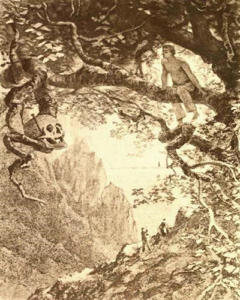
The True Story of Oak Island and Arcadia. By Cort Lindahl – KGRA Digital Broadcasting
Along the way, this incredible story will include Dante, Sir Francis Bacon, the de Vere family, Edgar Allan Poe, The Pre-Raphaelite Brotherhood, Joaquin Miller, Henry Wadsworth Longfellow (who wrote “Evangeline” about Arcadia and had family there), Samuel Morse, James Fenimore Cooper, Thomas Jefferson, Ben Franklin, George Washington (and descendants), Franklin D. Roosevelt and too many more to list. It is clear that organizations such as the Wilton Writer’s Circle and the Academy of Arcadia had communicated themes used in these mysteries in architecture, art, and literary forms. Does it mean there is no treasure anywhere? Absolutely not. However, this information may change how people view places like Oak Island, Rennes le Chateau, and the Beale Treasure region. The treasure begins with the monumental literary works, architecture, and art created by these people.
Part 2, The True Story of Oak Island, and Arcadia’s conclusion will appear in the KGRAdb Newsletter’s next edition.
Cort Lindahl is a researcher and author who has appeared as an expert in history on various television shows, including Oak Island. Look for more of his work at survivalcell.blogspot.com.

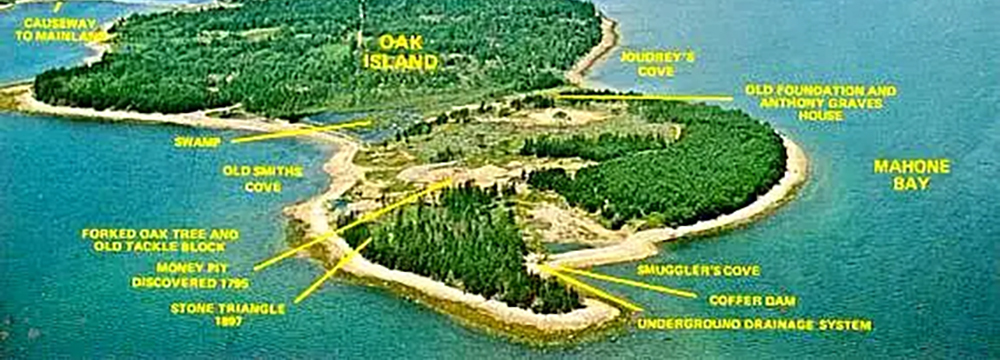



 KGRA Digital Broadcasting
KGRA Digital Broadcasting KGRA Digital Broadcasting
KGRA Digital Broadcasting